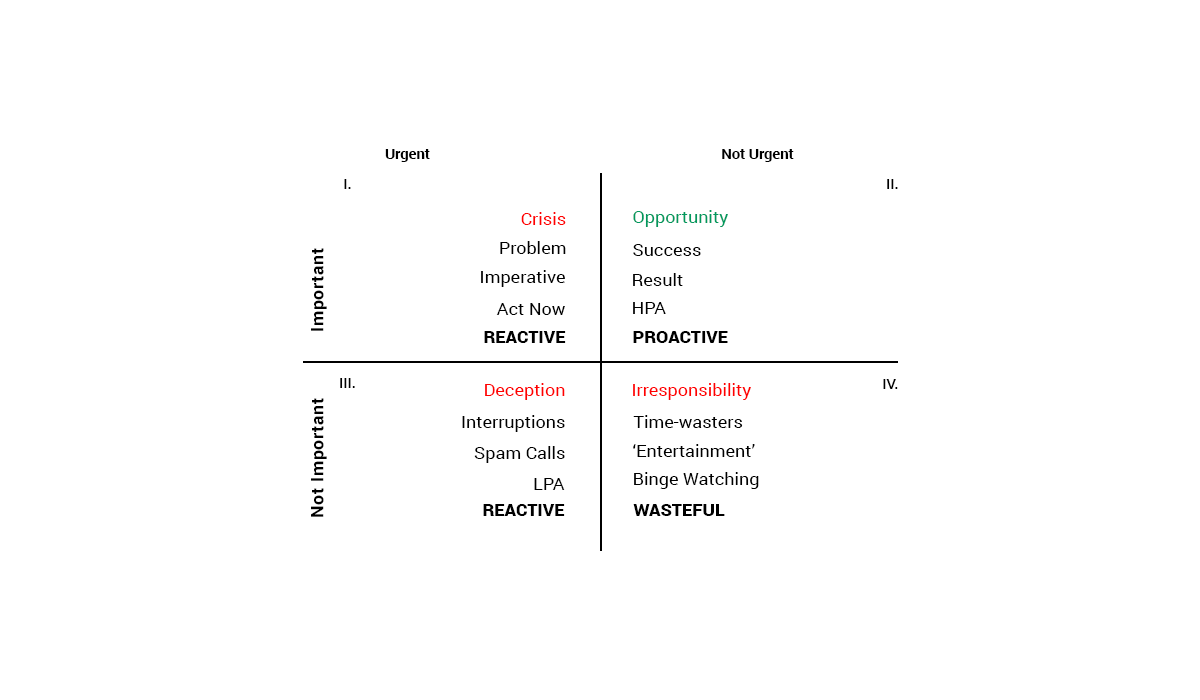“The key is not to prioritize what’s on your schedule, but to schedule your priorities.”
Stephen Covey
Feeling overwhelmed by your never-ending to-do list? You’re not alone. Staying productive can feel like an uphill battle. The key to achieving more isn’t working harder, it’s working smarter. And that means spending your time on your high pay-off activities (HPA) consistently.
The blog discusses a few tools that you can use to identify your HPAs. So you can spend your time where it is most productive, ie, moves you towards your goals the quickest.
I’ll touch on five of these tools; you can use these tools independently, but they generate the most value when you use a few of them together per your needs. I’ll touch on some examples as I describe them.
- Eisenhower Matrix
- ABCDE Method
- Pareto Principle (or the 80/20 rule)
- 1-3-5 Rule
- MoSCoW Method
Eisenhower Matrix
Dwight D. Eisenhower, the 34th president of the United States, once said, “The most urgent is seldom the most important.” The Eisenhower Matrix, also known as the Urgent-Important Matrix, captures this wisdom perfectly. This method categorizes tasks based on urgency (urgent vs. not urgent) and importance (important vs. not important).
It’s crucial to differentiate important from urgent. Urgent requires you to act now, where in most cases, important does not, even though ‘important’ is what moves you towards your targets and goals. For example, a ringing phone is urgent because if you don’t pick it up, it’ll stop ringing and you won’t have the opportunity to pick it up. But is it important? Most probably not. If you are already working on something that is important to you, give that a priority and less the urgent and not-important pass.
In some cases, a task may be urgent and important. An accident in the family that requires you to act right away is both urgent and important.
Something that is neither urgent nor important is a time waster for the most part. Unfortunately, we tend to spend quite a lot of time here if we are not conscious. An easy example is entertainment. Some entertainment is necessary, but binge watching or channel browsing is neither urgent nor important, and quite an irresponsible way of spending time.
The trickiest of these is the not-urgent and important quadrant. Since this is not urgent, it doesn’t call you, but this is also where you should spend your time, since this is where HPAs live and growth happens.
To use this matrix, categorize your tasks in these four quadrants, and then make an effort to reduce your time in all other quadrants and put that time here. The more you can take care of the important tasks, the more urgent shrink. All you have to do is start this process. It quickly becomes a virtuous cycle that continues to give you more time by reducing your urgent tasks. How exactly does that happen? Because when you focus on important, you automatically take care of many urgent tasks before they become urgent.
For further detail, check out Steve Covey’s 7 Habits of Highly Effective People.

ABCDE Method
Brian Tracy’s ABCDE method provides a structured approach to prioritization, guiding individuals to categorize tasks into five levels of importance:
A – must do tasks
B – should do; if you don’t do these tasks, the consequences are minor
C – nice to do; these usually have no or almost no consequences
D – delegate, and
E – eliminate
This method emphasizes the importance of distinguishing between tasks that are urgent and those that are genuinely important (see the Eisenhower matrix above).
“Always work on your most important task before anything else.”
Tracy advises
For further detail, check out Brian Tracy’s excellent blog, How To Set Priorities Using The ABCDE Method.
You’d notice that A- and B-type activities fall in quadrant II of the Eisenhower matrix, C and D fit somewhat in quadrant III and E corresponds to IV. There is no mention of quadrant I in ABCDE method because when an activity is urgent, you don’t have time to prioritize it; you just have to get it done.
Pareto Principle (the 80/20 Rule)
The Pareto Principle, named after economist Vilfredo Pareto, asserts that roughly 80% of results come from 20% of efforts. This principle underscores the importance of identifying the vital few, approximately 20% of your tasks (the “high pay-off activities”, HPAs) that yield the most significant outcomes.
As entrepreneur and author Richard Koch writes,
“The 80/20 Principle asserts that a minority of causes, inputs, or effort usually lead to a majority of the results, outputs, or rewards.”
By focusing on the critical 20% of activities, individuals can amplify their productivity and achieve more with less.
How do you find those 20% of the tasks, use the Eisenhower matrix: your quadrant II activities will make up most of your 20%. Or use the ABCDE method, where A and B activities became the 20%.
1-3-5 Rule
This technique is a simple way to structure your daily workload. Each day, identify one critical task (1), three important tasks (3), and five less important tasks (5). This helps you stay focused on high pay-off activities (HPAs) while acknowledging the need to address other obligations.
The use of this rule is a little different from the first three we’ve seen. The previous methods focus on your big tasks over a longer period of time, e.g. your weekly, monthly or even yearly tasks (leading towards your longer term goals). The 1-3-5 rule brings the same prioritization to the daily level.
The first task of each day should come from your quadrant II, or if you prefer should be your A-type task. The 3 important tasks are B-type and the 5 less important tasks can be either B or C. Notice no D and E here, and no mention of quadrant I or IV here.
MosCoW Method
I don’t like this method as much since it’s quite basic compared with the other methods mentioned here. However, lately it has become more popular specially in project management and software development circles, and is used mainly for feature-sets as a software is planned in early stages.
MoSCoW stands for
Must-Have,
Should-Have,
Could-Have,
Won’t-Have.
You can use the same concept for tasks: must do, should do, could do and wont do.
The main difference is the ‘wont do’ category here. This forces you to focus on tasks that you won’t do (quadrant III and IV tasks.) Any time you thus save can go into Must and Should do tasks.
I like the first two methods, the first one from a conceptual level and the second for more practical categorization. The best method however is the one that works for you. Experiment with these methods and find the approach that helps you achieve maximum productivity.
Remember,
“You can have it all. You just can’t have it all at once,”
Oprah Winfrey
Prioritization is about making conscious choices about what matters most and tackling those tasks first. With the right tools and mindset, you can conquer your to-do list and achieve your goals.

